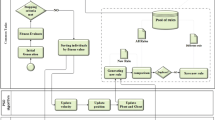Abstract
The most challenging issues in association rule mining are dealing with numerical attributes and accommodating several criteria to discover optimal rules without any preprocessing activities or predefined parameter values. In order to deal with these problems, this paper proposes a multi-objective particle swarm optimization using an adaptive archive grid based on Pareto optimal strategy for numerical association rule mining. The proposed method aims to optimize confidence, comprehensibility and interestingness for rule discovery. By implementing this method, the numerical association rule does not require any major preprocessing activities such as discretization. Moreover, minimum support and confidence are not prerequisites. The proposed method is evaluated using three benchmark datasets containing numerical attributes. Furthermore, it is applied to a real case dataset taken from a weight loss application in order to discover association rules in terms of the behavior of customer page usage.






Similar content being viewed by others
References
Larose DT, Larose CD (2014) Discovering knowledge in data. An introduction to data mining. Wiley, Hoboken
Agrawal R, Imielinski T, Swami A (1993) Mining association rules between sets of items in large databases. In: Proceedings of the 1993 ACM SIGMOD international conference on management of data, Washington, D.C.
Ghosh A, Nath B (2004) Multi-objective rule mining using genetic algorithms. Inf Sci 163:123–133
Beiranvand V, Mobasher-Kashani M, Abu Bakar A (2014) Multi-objective PSO algorithm for mining numerical association rules without a priori discretization. Expert Syst Appl 41:4259–4273
Minaei-Bidgoli B, Barmaki R, Nasiri M (2013) Mining numerical association rules via multi-objective genetic algorithms. Inf Sci 233:15–24
Alatas B, Akin E, Karci A (2008) MODENAR: multi-objective differential evolution algorithm for mining numeric association rules. Appl Soft Comput 8:646–656
Mata J, Alvarez J-L, Riquelme J-C (2002) Discovering numerical association rules via evolutionary algorithm. In: Pacific-Asia conference on knowledge discovery and data mining, Taipei
Freitas AA (1998) Data mining and knowledge discovery with evolutionary algorithm. Springer, New York
Qodmanan HR, Nasiri M, Minaei-Bidgoli B (2011) Multi objective association rule mining with genetic algorithm without specifying minimum support and minimum confidence. Expert Syst Appl 38:288–298
Talbi E-G (2009) Metaheuristics from design to implementation. Wiley, New Jersey
Arqub OA, Abo-Hammour Z (2014) Numerical solution of systems of second-order boundary value problems using continuous genetic algorithm. Inf Sci 279:396–415
Heraguemi KE, Kamel N, Drias H (2016) Multi-swarm bat algorithm for association rule mining using multiple cooperative strategies. Appl Intell 45:1021–1033
Cheng S, Liu B, Ting TO, Qin Q, Shi Y, Huang K (2016) Survey on data science with population-based algorithms. Big Data Anal 1:3
Eberhart R, Kennedy J (1995) A new optimizer using particle swarm theory. In: Proceedings of the sixth international symposium on micro machine and human science, 1995, MHS ‘95, pp 39–43
Engelbrecht AP (2005) Fundamentals of computation swarm intelligence. Wiley, England
Coello CAC, Pulido GT, Lechuga MS (2004) Handling multiple objectives with particle swarm optimization. IEEE Trans Evol Comput 8:256–279
Adamo J-M (2001) Data mining for association rules and sequential patterns. Springer, New York
Fidelis MV, Lopes HS, Freitas AA (2002) Discovering comprehensible classification rules with a genetic algorithm. In: Proceedings of the 2000 congress on evolutionary computation. IEEE, California, pp 805–810
Eberhart RC, Yuhui S (2001) Particle swarm optimization: developments, applications and resources. In: Proceedings of the 2001 congress on evolutionary computation, Seoul, vol 81 pp 81–86
Knowles J, Corne D (2000) Approximating the nondominated front using the pareto archived evolution strategy. Evol Comput 8:149–172
Guvenir DHA, Uysal I (2000) Function approximation repository. Bilkent University, Ankara, Turkey. http://funapp.cs.bilkent.edu.tr/DataSets/
Kuo RJ, Zulvia FE, Suryadi K (2012) Hybrid particle swarm optimization with genetic algorithm for solving capacitated vehicle routing problem with fuzzy demand—a case study on garbage collection system. Appl Math Comput 219:2574–2588
Kuo RJ, Kuo PH, Chen YR, Zulvia FE (2016) Application of metaheuristics-based clustering algorithm to item assignment in a synchronized zone order picking system. Appl Soft Comput 46:143–150
Alatas B, Akin E (2008) Rough particle swarm optimization and its applications in data mining. Soft Comput 12:1205–1218
Alataş B, Akin E (2005) An efficient genetic algorithm for automated mining of both positive and negative quantitative association rules. Soft Comput 10:230–237
Alatas B, Akin E (2009) Multi-objective rule mining using a chaotic particle swarm optimization algorithm. Knowl-Based Syst 22:455–460
Author information
Authors and Affiliations
Corresponding author
Ethics declarations
Conflict of interest
The authors declare that they have no conflicts of interest.
Ethical approval
This article does not contain any studies with human participants or animals performed by any of the authors.
Rights and permissions
About this article
Cite this article
Kuo, R.J., Gosumolo, M. & Zulvia, F.E. Multi-objective particle swarm optimization algorithm using adaptive archive grid for numerical association rule mining. Neural Comput & Applic 31, 3559–3572 (2019). https://doi.org/10.1007/s00521-017-3278-z
Received:
Accepted:
Published:
Issue Date:
DOI: https://doi.org/10.1007/s00521-017-3278-z




